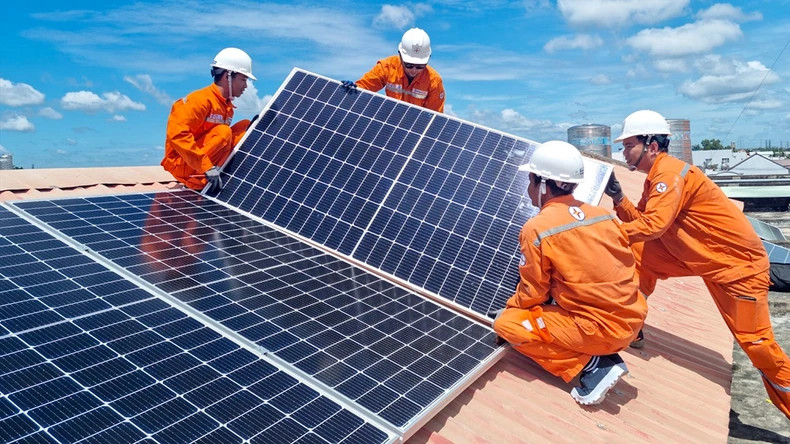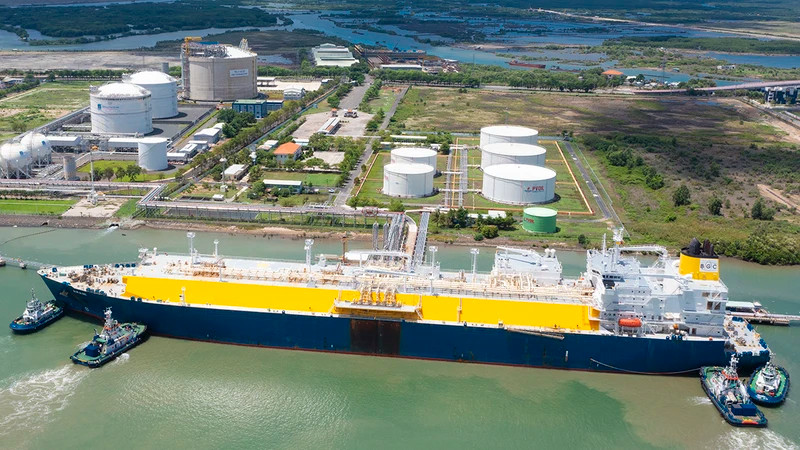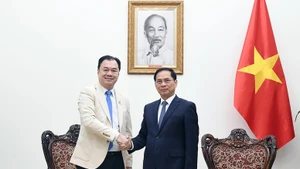However, in the implementation process, businesses encounter “bottlenecks” in terms of law, finance, policy, etc., leading to a lack of synchronisation of socio-economic and environmental development goals, failing to meet the long-term vision of energy.
To promote energy transition, the state needs to implement preferential mechanisms and policies that are innovative, simplify administrative procedures, support human resource training, and reduce challenges in developing renewable energy projects.
Opportunities for businesses
According to the Vietnam Federation of Commerce and Industry (VCCI), Vietnam has been assessed as having ideal geographical and climatic characteristics, with a long coastline, tropical monsoon weather, and relatively large amounts of solar radiation and wind for renewable energy production. Vietnam has developed a clear, long-term energy development policy through the promulgation of the National Power Development Plan for the 2021-2030 period, with a vision to 2050 (Power Plan VIII).
Accordingly, Vietnam aims to promote the development of renewable energy sources, sharply reduce coal-fired thermal power, reasonably develop gas power sources using liquefied natural gas (LNG), and use biomass power sources in the power generation structure to match the general trend in the world. The government has also demonstrated its determination for this transition through the net zero commitment at the 26th United Nations Climate Change Conference of the Parties (COP26).
The Power Plan VIII has set a target of using 31-39% of electricity from renewable energy sources by 2030 and 68-72% by 2050; establishing two inter-regional renewable energy industrial and service centres in Vietnam’s North, South Central and South regions.
According to Abhinav Goyal, Director of Investment Project and Infrastructure Advisory Services at PwC Vietnam, if there is good preparation for the energy transition process associated with energy infrastructure development, it will encourage Vietnam to achieve synchronous economic and social development goals, ensuring green and sustainable development goals in the future.
The energy transition will have a direct impact and bring opportunities for service developers and technology providers when introducing renewable energy solutions in new fields, as well as coordinating with government agencies and businesses to jointly develop policies to support new products and services. At the same time, opportunities will also come to other businesses in localisation, providing new services in the renewable energy supply chain, global supply chain, etc.
From a business perspective, CEO of May 10 Corporation Ha Manh said that sustainable development and “greening” the textile industry is the direction that May 10 is aiming towards to meet the requirements of import markets. However, the characteristics of solar power depend on the weather and infrastructure conditions of each business. If the rooftop solar power system is completed, the clean power supply rate for the maximum power consumption will only reach 30%.
Therefore, to meet the requirements of green production, May 10 is eager to find more solutions and sources of clean energy for production activities. This is also a new opportunity for Vietnamese enterprises to participate in the green transformation supply chain in the production process, moving towards a circular economy in the future; thereby creating new sources of revenue for enterprises, reducing energy costs, improving brands, and promoting the energy transition in a fair and sustainable manner.
 |
| Ho Chi Minh City Power Corporation workers install rooftop solar power systems. (Photo: NAM DUONG) |
Removing “bottlenecks”
Pointing out the opportunities for businesses in the green hydrogen sector, Le Ngoc Anh Minh, Chairman of the ASEAN Vietnam Hydrogen Club, said that the first opportunities will come to businesses providing technical and legal consulting services, providing advice to the government on low-emission hydrogen standards and international standard derivatives according to the International Energy Agency (IEA) to complete the H2/2025 and NH3/2026 standards.
In addition, with the Politburo's decision to invest in the construction of a high-speed railway project on the north-south axis, opportunities will also come to businesses supplying hydrogen energy in cooperation in exploiting trains using hydrogen fuel cells, calculating low-emission hydrogen sources to operate trains. Notably, Vietnam has large natural hydrogen reserves, this is also an opportunity for businesses exploring and exploiting natural hydrogen to take advantage of the strengths of Vietnam's offshore oil and gas industry.
Although the development of renewable energy in Vietnam has recorded significant progress thanks to the state's incentive mechanisms and policies to promote development, energy transition, and ensure national energy security, many experts and businesses claim there are still legal bottlenecks and policy barriers that need to soon be identified and removed.
In particular, financial resources and promoting science and technology development to help businesses implement a strategy to deeply reduce carbon emissions in the future have not really received due attention. Furthermore, Vietnam still lacks a highly skilled workforce for the field of installation, maintenance and repair of renewable energy systems for stable and long-term operation and maintenance.
New energy projects will face difficulties and challenges when they require very large initial investment costs, but current financial products are not diverse nor long-term enough to meet the needs. New financial mechanisms such as blended finance, green bonds and loans or sustainability linkages and credit efficiency enhancement tools have not been widely used.
Vo Quang Lam, Deputy General Director of the Vietnam Electricity (EVN)
In addition, the policy issuance process takes a long time, licensing is complicated, and administrative procedures are cumbersome, these are the main reasons that negatively affect project progress. In addition, there are still gaps in the domestic supply chain of the new energy industry, when most of the components and equipment serving renewable energy projects in Vietnam are not self-sufficient and still depend on imports.
In addition to financial and human resource difficulties, policy shortcomings are also bottlenecks in the process of promoting energy chain transformation in Vietnam. Many businesses hope that the state needs to devise mechanisms and policies to promote the implementation of a direct electricity trading mechanism between electricity users and clean electricity suppliers instead of through the national electricity grid as stipulated in Decree No. 80/2024/ND-CP.
Only then will it create opportunities to promote increased investment, maximise investment resources in enterprises and society in developing renewable energy projects; help manufacturing enterprises be more proactive in solving the supply and demand of renewable energy, proving that the use of clean electricity supply for production accounts for a high proportion; thereby ensuring the achievement of "green certificates" for goods for export, as well as removing difficulties for many renewable energy projects that are late in the preferential FIT (Fit-for-Electricity Tariff) period.
The transition to renewable energy production and use will bring good opportunities for Vietnam. If Vietnam can master the technology, it will help it become a centre for energy transition in Southeast Asia. Therefore, it is necessary to have a long-term strategy in developing localisation and removing procedural bottlenecks, including simplifying and accelerating the licensing process for renewable energy projects to attract investment; devising more incentive mechanisms and clear guidelines for businesses investing in energy infrastructure such as stations and transmission lines to participate; increasing green credit limits for businesses; etc.
















